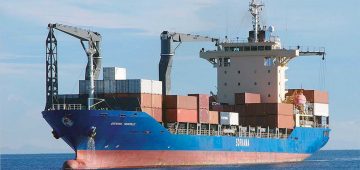Introduction
As described in detail in the November edition of Shipping Today and Yesterday, the Ravano family of Genoa had purchased their first steamships shortly before the First World War. Proceeding to become one of Italy’s larger tramp operators, in 1946 Alberto Ravano created Tidewater Commercial Co. Inc. (Tidewater) in the United States. Initially operating a 1902 built part passenger ship, given the name Tidewater, and some former U.S. colliers, a large fleet of dry cargo ships and tankers, placed under the Panama and Liberia flags, was managed by Tidewater until the mid 1980s.
Tidewater, initially established in California, was incorporated at Baltimore, Maryland, in February 1947. The Company’s general manager was Captain Paolo S. Saglietto who from 1927 to 1939 had served as master on board Ravano ships. When, in December 1941, his command San Giuseppe was seized by the United States Government at Norfolk, Virginia, he was interned for the remainder of the War.
After the War ended Captain Saglietto became a member of the Italian Technical Delegation formed to purchase Liberty ships from the United States Government and Alberto Ravano soon became its Chairman. The newspaper Baltimore Sun had reported in 1966 that Capt. Saglietto had been awarded the Caveliere Officiale Order of Merit of Republic of Italy, for fostering goodwill between the United States and Italy. Although Tidewater itself ceased shipowning in 1956 for a period of about six years until 1962, the fleets which the Company managed on behalf of Alberto Ravano were at that time fast expanding.

First Ships
Tidewater’s first ship is of much historic interest. Built at Sparrows’ Point by the Maryland Steel Corporation as Shawmut for the Boston Steamship Company, she had passed in 1909 to the United States Government owned Panama Railroad Company of New York and renamed Ancon. On 15 August 1914 she carried 300 guests for the first official transit of the Panama Canal from Cristobal to Balboa and in early 1919, as U.S.S. Ancon, she made two trips repatriating American servicemen from France.
Together with her sistership Cristobal, the Ancon was mainly employed transporting building materials from New York to the Canal construction areas and, after being given passenger accommodation in 1924, to Haiti and the Panama Canal zone. At some point prior to August 1939, when she was reactivated for the Canal’s 25th anniversary, the Ancon was laid up prior to sale. In October 1940 she was purchased by the Kaiser Group’s Permanente Cement and given her owning company’s name. Initially used to ship cement, the Permanente was soon put to use as a supply ship in the Pacific followed in 1946 by a voyage from Australia to the United States carrying War brides.
Subscribe today to read the full article!
Simply click below to subscribe and not only read the full article instantly, but gain unparalleled access to the specialist magazine for shipping enthusiasts.



Comments
Sorry, comments are closed for this item